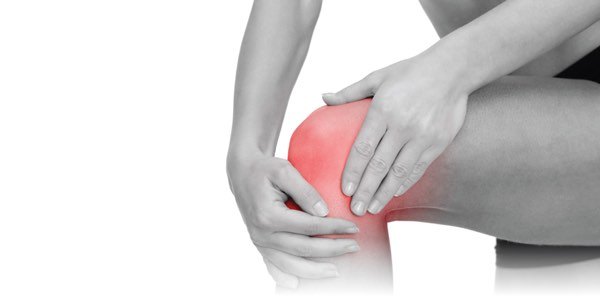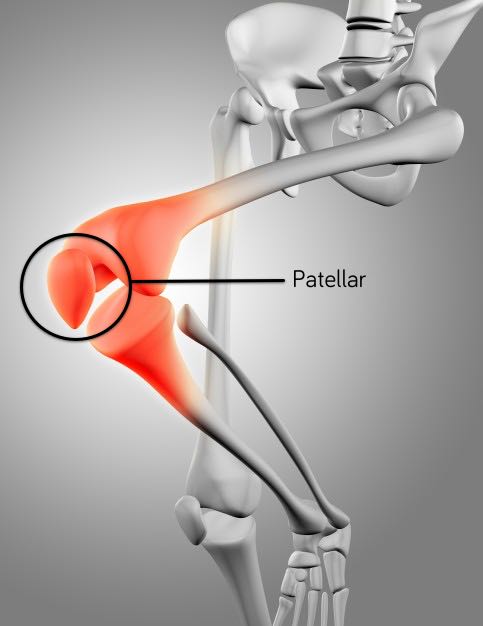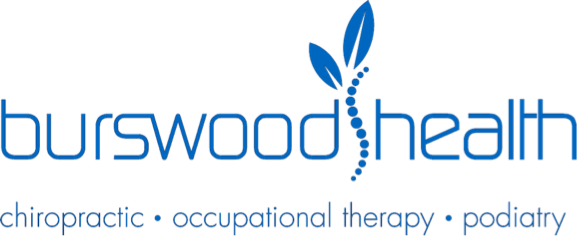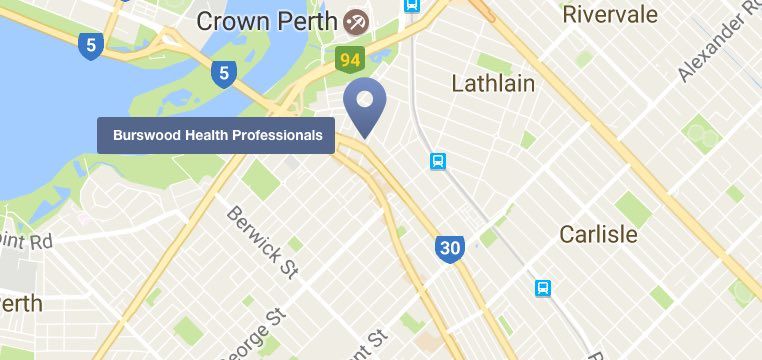Knee Pain
Knee pain is one of the most common problems we treat at Burswood Health. And while many patients experience some sort of knee pain as a natural part of getting older, there are also a few common conditions that can cause knee pain.

Knee Pain Explained
Most people think chiropractors only treat back and neck pain. This misconception is far from the truth. Chiropractors treat more than backs and bones. In fact , at Burswood Health we call ourselves 'muscle chiropractors' because a cornerstone of our therapeutic approach is the assessment and treatment of muscles and connective tissue. And we treat the entire musculoskeletal systems - from head to toe, jaws and arms. The body functions as a whole, and the thigh bones connected to the knee bone - and on and on.
No where is this more true than in the knee joint. Knee pain is one of the most common problems we treat at Burswood Health. And while many patients experience some sort of knee pain as a natural part of getting older, there are also a few common conditions that can cause knee pain.
Your chiropractor will first look at the exact cause of your discomfort and then provide you with a diagnosis. Once we have clarity on what is causing your knee pain, we will work out a customised treatment plan.
Importantly, knee pain can be caused by a low back or hip problem which refers pain to the knee - or foot problems which affect how your legs function when you walk.
There are many causes of knee pain - some within the joint and others from tissues outside the knee itself. Here are a few of the common, but potentially debilitating problems we treat:
Torn meniscus
A meniscus is a fibrocartilage pad that acts as a shock-absorber that separates the femur (thigh bone) from your tibia (shin bone). It is commonly referred to as your 'cartilage'. Each knee joint has a medial meniscus and a lateral meniscus. A tear in a meniscus is commonly caused by trauma (twisting) or degeneration caused by repetitive stress over time. Symptoms often include clicking, popping, locking, swelling and pain. Significant tears can cause locking and severe pain. Mild or small tears can be managed nicely without drugs or surgery.
Bursitis
Small fluid sacs (bursae) act like a cushion, on the outside of your knee joints. Through overuse or biomechanical dysfunction, a bursa can become inflamed - resulting in bursitis. In this case your tendons and ligaments will no longer glide smoothly and the involved part of the knee becomes very painful.
Kneeling on the knee for prolonged periods can cause 'housemaid's knee' or bursitis - as can poor footwear or pronation of the feet which results in significant stress in the knee with each step you take.
Determining the cause of bursitis is the key to treating this painful condition properly.
Other Pain You Might Feel
Foot Pain
Are you suffering from ongoing foot pain? Read about what could be the cause of your pain and how we can help.
Osteoarthritis
Inside each joint there is abundant cartilage which acts as a cushion and shock absorber. This natural cushioning dries out and can wear away as you get older, allowing the bones of the joint to rub against each other. The cartilage is no longer resilient enought to absorb shock and allow full movement of the joint. This is known as osteoarthritis. Inflammation within the joint results in knee pain, stiffness, swelling and a sense of weakness or instability as the condition progresses. The pain from knee osteoarthritis can interfere with the most basic daily tasks such as walking, driving and cooking. Arthritis treatment in centered around controlling the symptoms and slowing down the process through physical therapy, exercise prescription and lifestyle advice.
Recent research published in Arthritis Care and Research (2017; online) showed that frequency of grating, cracking or popping of the knee joints had a threefold higher risk of developing knee arthtritis in the following year compared to those without crepitus. This was based on a US study of almost 3500 middle-aged people.The researchers stated "Our study suggests crepitus is not completely benign. It's a sign that something is going on in the knee joint." If you have clicking, grating or popping knees - it makes sense to get an earlier diagnosis and get on an effective intervention program before the condition becomes advanced.
Patellar Tracking Problems
Our knee cap should glide smoothly and evenly as we flex and extend our leg. When the knee cap (or patellar) doesn't 'track' or move evenly, the front of the knee can become very tender and painful. The area behind the knee cap can wear down over time - and this is known a chondromalacia patellae. So the problem starts with poor tracking - due to a weak inner quadriceps muscle or poor gait pattern. Young, active adolescents and athletes often experience patellar pain because they are using their knees to such a high degree. And a small amount of knee cap misalignment can result in a very painful knee condition.
Treatment always begins with an accurate assessment of the cause of the problem. The treatment program we choose is always based on your individual condition. We often use cold laser treatment, muscles therapy and always prescribe exercises. A biomechanical assessment by our podiatrist is essential in order to ensure your gait - or walking pattern - is optimal and not in need of correction.

Patellar Tendonitis
Tendons are the end structure of a muscle that attaches it to bone. Tendonitis means that one of the tendons (or more!) are inflammed. This often occurs as a result of overuse or overload. Symptoms of tendonitis include pain, stiffness and decreased range of motion.
Patellar Tendonitis means the tendons in your knee are affected. This is often linked to cycling or running or walking. Poor foot wear, improper bike set-up, the need for orthotics and inadequate rest or stretching are often areas we need to address.
Trigger Points
Trigger points are tender, tense nodules located in muscle, tendon, or ligaments. Trigger points can refer pain to other areas in the body. Most people are unaware that they have trigger points that are causing neck, back or limb pain. Trigger points in the thigh muscles often radiate pain into the knee. And they can cause a sudden 'buckling' or giving way of the knee joint.
Incorrect use of certain muscles, repetitive movements, muscle strain are some of the things that can cause the development of trigger points. You may have had a scan, and everything looked fine. "There is nothing wrong with your knee." But trigger points can only be detected by a thorough examination of the musculoskeletal system. In the case of knee pain we look at your hamstrings, iliotibial band and quadriceps, along with your hip, leg and low back musculature. In chronic cases, such as osteoarthritis, trigger points are always involved. Soft tissue therapy (trigger point therapy) is the most effective way to treat trigger points, eliminate pain and restore strength to the muscles that move and protect the knee.
Surgery for Knee Pain?
Until recently, it was assumed that a torn meniscus, left untreated, would accelerate osteoarthritis. Therefore surgery for meniscal repair or removal was normally recommended. Dr Frank Roemer found that surgical intervention accelerated osteoarthritis in 100% of the participants one year following surgery. The patients who had a meniscal tear and no surgery were still at risk for developing osteoarthritis - but at a vastly lower rate than the group who had the operation.
The authors concluded "Meniscal surgery has deleterious effects on joint structure in knees without obvious osteoarthritis." The decision for meniscal surgery needs to be carefully considered in order to avoid accelerated disease onset. Conservative care of a damaged cartilage, therefore, is warranted. Manual therapy with rehabilitation is in your best interest.
How can you get rid of knee pain?
Many conditions can be effectively managed and it all starts with a proper assessment and diagnosis by your chiropractor. A variety of therapies can be used to reduce the inflammation of your knee joint and the surrounding muscles. Soft tissue therapy, trigger point therapy, cold laser and acupuncture can all be used in the initial and rehabilitation phase of treatment. Our whole team at Burswood Health will help ensure that your knee joints and muscles are working as optimally as possible. Your legs and feet need to be strong and pain free. They have to carry you for many kilometres and many years. If you suffer from knee pain, make an appointment with our friendly staff and see how we can help you.
Available Treatments
Here's a DIY exercise
Reference:
Roemer,F. et al, Meniscal Surgery Markedly Increases Risk ofr Incident Osteoarthritis and Cartilage Loss in the Following Year. Radiological Society of North America 2014 Scientific Assembly and Annual Meeting Nov-Dec 2014.


